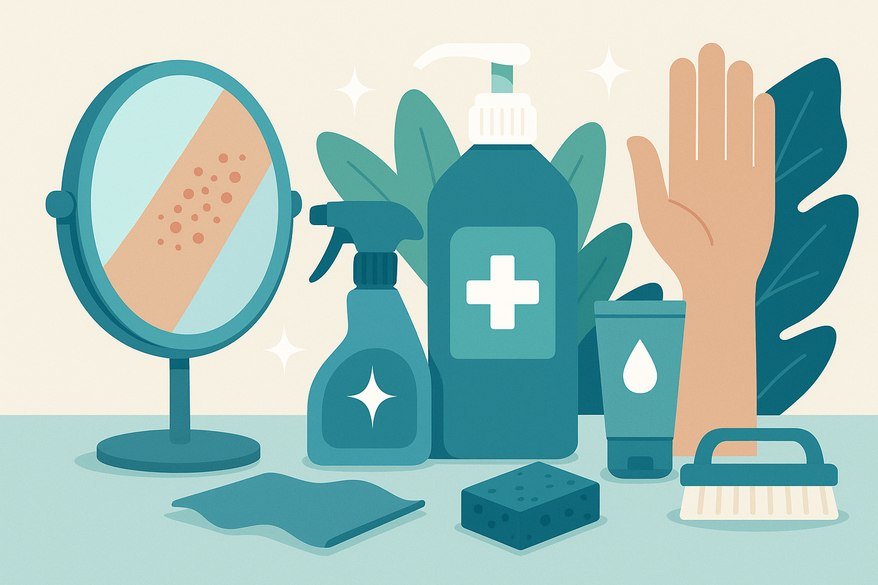Cleaning Product Rash: Causes, Prevention & Treatment
Discover the causes, prevention tips, and treatment options for cleaning product rash to keep your skin healthy while maintaining a clean home.

Estimated reading time: 6 minutes
Key Takeaways
- Contact dermatitis: Cleaning product rash is a common skin reaction from harsh household chemicals.
- Symptoms: Redness, itching, cracking and fluid-filled blisters often appear on hands and forearms.
- Causes: Irritant and allergic pathways involve bleach, ammonia, detergents, disinfectants and fragrances.
- Prevention: Wear gloves, ensure ventilation, choose hypoallergenic products and moisturize regularly.
- Treatment: Rinse skin, use emollients or hydrocortisone cream and seek a dermatologist if severe.
Table of Contents
- What Is a Cleaning Product Rash?
- Common Culprits in Cleaning Products
- How Do Cleaning Products Cause Skin Rashes?
- Risk Factors & Who’s Most Likely to Be Affected
- Prevention Tips & Safety Measures
- First Aid & Treatment Options
- Additional Resources & Expert Advice
- Conclusion
- FAQ
What Is a Cleaning Product Rash?
Cleaning product rash is a form of contact dermatitis that manifests as red, itchy or blistered skin after direct exposure to household cleaners. Symptoms typically develop on the hands and forearms within minutes to hours of contact.
Common Culprits in Cleaning Products
- Bleach (Sodium hypochlorite) – Strips natural oils, breaking down the skin barrier. (Epiphany Dermatology)
- Ammonia – Fumes and liquid irritate and erode the outer skin layer. (WebMD)
- Detergents & surfactants – Dissolve skin lipids, leaving skin dry and vulnerable. (NHS)
- Disinfectants – Strong biocides that inflame healthy skin. (Epiphany Dermatology)
- Fragrances & preservatives – Trigger immune responses in sensitive individuals. (Mayo Clinic)
How Do Cleaning Products Cause Skin Rashes?
- Irritant contact dermatitis:
- Repeated or prolonged exposure breaks down the protective skin layer.
- Leads to dryness, redness, cracking and burning. (Mayo Clinic, NHS)
- Allergic contact dermatitis:
- Immune system reaction to allergens like fragrances or preservatives.
- Causes histamine release, itching, swelling and redness in sensitized individuals. (Epiphany Dermatology, Mayo Clinic)
Contributing factors include chemical concentration, frequency of exposure and individual sensitivity (e.g., eczema or very dry skin).
Risk Factors & Who’s Most Likely to Be Affected
- Individuals with sensitive skin or atopic eczema. (WebMD, NHS)
- Known allergies to cleaning ingredients. (Mayo Clinic)
- Occupational exposure: professional cleaners, healthcare staff, hairdressers, food-service workers. (occupational dermatitis management guide)
- Poor usage habits: skipping gloves, over-spraying and insufficient ventilation.
Prevention Tips & Safety Measures
- Wear protective gloves and clothing. (Epiphany Dermatology)
- Ensure proper ventilation by opening windows or using fans. (WebMD)
- Choose hypoallergenic, fragrance-free or natural products.
- Moisturize hands daily with gentle, fragrance-free creams. (WebMD)
- Follow label instructions on dilution and safe handling.
- Wash exposed skin with mild soap and warm water immediately after cleaning.
First Aid & Treatment Options
At the first sign of rash:
- Rinse the affected area thoroughly to remove residual chemicals. (WebMD)
- Apply soothing emollients or hydrocortisone cream to reduce inflammation.
- Discontinue use of the offending product and switch to a milder alternative.
Seek professional care if the rash is extensive, painful, shows signs of infection or fails to improve within a few days. A dermatologist can prescribe stronger treatments and perform allergy testing.
Additional Resources & Expert Advice
For further guidance, see:
- Mayo Clinic contact dermatitis overview
- NHS advice on causes & prevention
- WebMD guide to skin irritants
“Proper diagnosis helps you treat the rash effectively and avoid future flare-ups,” says Dr. Dawn Davis, board-certified dermatologist. (Mayo Clinic)
Conclusion
Cleaning product rash need not derail your routine. By recognizing symptoms early, adopting simple safety habits—like wearing gloves and choosing gentle cleaners—and knowing when to seek medical help, you can maintain both a spotless home and healthy skin.
FAQ
- What type of rash is caused by cleaning products?
- It’s usually contact dermatitis, either irritant (chemical damage) or allergic (immune reaction).
- How can I prevent a cleaning product rash?
- Wear protective gloves, ensure good ventilation, use hypoallergenic products and keep skin moisturized.
- When should I see a doctor?
- If the rash is severe, widespread, shows signs of infection or doesn’t improve with basic care.
- Can natural or “green” cleaners still cause rashes?
- Yes. Essential oils, solvents or preservatives in natural formulations can still irritate or trigger allergies.





